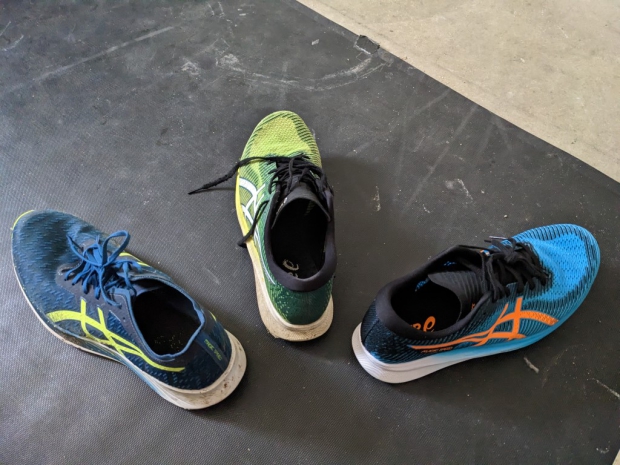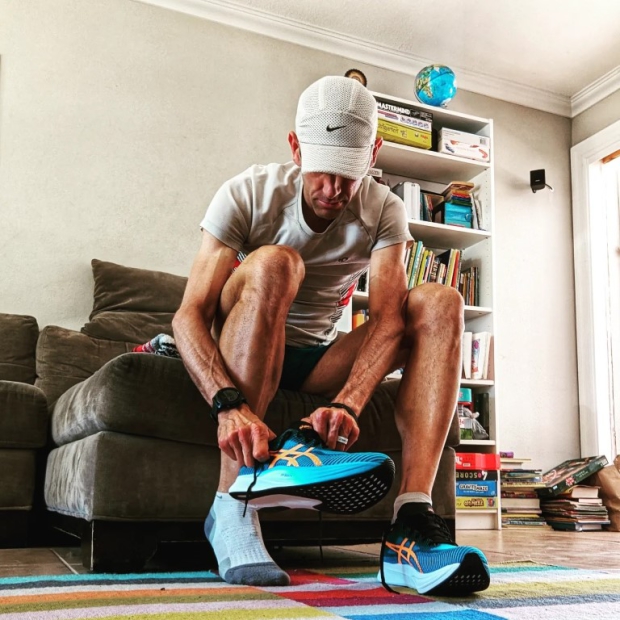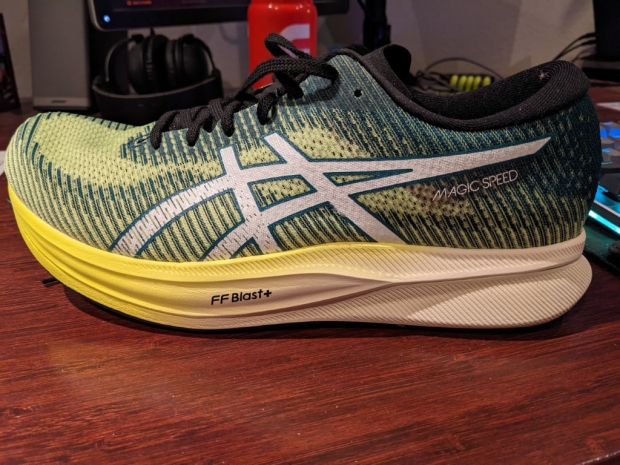MagicSpeed Is Magic

The Nike LunaRacer was the first shoe I ever really loved. I wore a pair during my first Ironman win in Penticton in 2009, and then a modified version – the Lunar Mariah – at Arizona that same year that in hindsight was a step down; I was looking for a roomier toebox, which the Mariah offered, but it wasn’t overall as good a shoe. The upper was heavier and more prone to water retention and was fundamentally a worse Ironman shoe. But the sole – the Lunar foam – was amazing. Lunar foam was probably ahead of its time; without a carbon fiber plate, the bounciness wasn’t as propulsive as the current generation of super shoes, and I think this is likely why it never really took off the way I believe Nike thought it would.
Along with the original Hoka Bondis, these shoes were a complete departure from the fairly minimal shoes I typically enjoyed running in. Though I think that a part of that enjoyment was learned behavior. This was during the height of the minimalist phase of shoes, and while I never fully bought into the idea that running in minimal shoes could make your feet stronger, I thought if if you paid attention to lower-leg and foot strength as I did, that minimal shoes were beneficial from a performance standpoint. That is, minimalist shoes were useful tools to get faster. There’s continued research supporting this – INSERT LINK, and I suspect much of my “enjoyment” of these shoes came from a sense that they were accretive to my performance on race day. And, over time, they just became familiar. And certainly I loved the light weight. That feeling of the shoes being barely there, especially since I ran mostly on trails and dirt roads.
From mid-2018 until early 2020, I stopped running entirely to focus on track cycling. Running wasn’t going to make me a faster cyclist, and I had not yet really come to appreciate training outside of the concept of competition. I loved training, but in a “type 2 fun sense of the word. I appreciated the process of training and the sense of becoming fitter and faster. Training was fun because of its utility. This didn’t diminish its fun from my perspective. I loved – and still love – that sense of purpose. I derive a tremendous sense of satisfaction from repetition and process. And so when running wasn’t really servicing any sort of larger goal, I just stopped doing it. At times, I missed it. But I was more consumed then by the larger goal and purpose of pursuit training, and so whatever emotional attachment I had to running was a distant second to the primary attachment I had to the process of becoming faster on the velodrome.

It wasn’t really until perspective was forced upon me by the Covid lockdown that I realized I just loved training for its own sake and for the simple joy of being active. And it was at this point, I started to run again. In the same minimalist shoes I’d always run in. But these minimal shoes were always facilitators of “type 2” fun. Starting during the lockdown, the idea of the “fun scale” has taken on a preeminent role in how I think about training and – more generally – being active in my post-professional life. For those who aren’t familiar with it, the fun scale classifies fun into three distinct categories:
– Type 1: this is fun while you are doing
– Type 2: this is hard – and possibly unpleasant – while you are doing it, but fun in retrospect. Type 2 fun is what is most typically associated with endurance sport.
– Type 3: this is fun that is not actually fun. Like, an idea that seemed good but wasn’t, either during or after.
I’ve written recently about how certain decisions have made training “more fun.” For clarity, what I really mean is that I’ve found ways to turn training from almost exclusively “type 2” fun into “type 1” fun. I’d admittedly not thought about this all that much as an idea – training was *always* type 2 fun; that’s just how things worked – until I read a profile in the NY Times of 2021 pursuit world champion, former pursuit world record holder, and current America’s Cup cyclor Ashton Lambie that presented the shocking (to me) idea that Ashton was satisfied to just … ride. The real nugget comes at the end, though, where a former boss of Lambie’s says that his super power is that he experienced endurance training and feats that should have been type 3 (aka “not fun”) as type 2 fun. I wondered if you couldn’t take this a step further. If you could enjoy something that you shouldn’t, could you change *how* you enjoyed something that you should? If Ashton could experience type 3 fun as type 2 fun, I wondered if I could experience type 2 fun as type 1 fun. Could I just enjoy the simple act of doing, outside of any larger sense of purpose? Like Ashton, I think I managed often to experience type 3 fun as type 2. I think my best races were always on hard courses – often in particularly brutal conditions – because I think I just liked those courses. Winning the inaugural Leadman 250 in Las Vegas, when high temperatures in the aptly named Valley of Fire national park hit well into the triple digits and the winds were so strong my lead motorcycle ran out of gas 20 miles from T2, was probably the most fun I can remember ever having on a race course. It was a race that in some ways seemed impossible. And it was perfect.

I’d always had fun training. I loved my time as a professional, but it was pretty much always type 2 fun. I loved the feeling of accomplishment. The satisfaction of setting a goal and achieving it. And it wasn’t that I disliked like it in the moment; it was more that I’d developed over many years an understanding of the value of that delayed gratification. Something was fun because it *would be* rewarding. But the idea that it could be rewarding in the moment? That was an interesting idea.
In 2022, I got pulled into running a Ragnar Road Ultra with some friends from work. And I thought, if only for the performance and energy savings/return over 36 miles, I ought to get a pair of super shoes to run it in. I tried a few different pairs but didn’t find any that really clicked. And then I tried the Asics MetaSpeed Sky, and I thought, “oh wow. These are fast. And … fun.” Running in the shoes felt a bit like a joke. The old adage is that there’s no such thing as “free” speed. And yet suddenly there was. I liked running in those shoes. They had all the bounce and enjoyment of the Lunars and Hokas, but with that added propulsive magic of the carbon plate. There was none of the sponginess of those other shoes. That sense that yes they felt good, but that the good feeling was coming at a cost. For the first time, the shoes that felt the best were also the fastest.

For reasons mostly of price and durability – and lingering questions about the possible detriments of running in fully-plated shoes for all runs, I knew that the MetaSpeeds would not be my everyday shoe. But was there something “close enough”? I’d always had a special fondness for Asics shoes both because of their incredible history and because the Asics Piranha was the shoe that allowed me to race an Ironman after my near fatal hit-and-run accident in 2010; yes, I ran Ironman Arizona 2010 in a pair of what Asics marketed as 5k flats, because the minimalist, low-profile offered a stability that kept excruciating IT band syndrome from accident at bay. The sponginess of the Lunar foam shoes set my IT band on fire, because I didn’t yet fully understand what I really liked in shoes – a wide toebox, a broad midfoot at the sole but not in the arch (I have high arches), and a snug upper. I want the sole to be wide at the midfoot, but the upper to be relatively narrow so as to offer a sense of support under my arch. Our own Ryan Heisler helped me distill this when I sent him a list of shoes that I had run in that I had liked and those that I had not liked. He wrote back and said, “this is what you want from a shoe.” And he was 100% right, and this razor has never really failed me since.

Having found joy in the Asics MetaSpeed Sky, I decided to try the first version of the Asics MagicSpeed. The MagicSpeed was Daniela Ryf’s shoe of choice for Ironman racing, and it’s certainly a race-competent shoe. But it’s not a “super” shoe. It’s really more of a “tempo trainer,” with good – but not super – foam. And a partial caron plate, at least in the first and second versions; the third version makes it more of a race-oriented shoe with a full-length plate and more race-y foam; most reviewers praise these changes, but with a couple hundred miles in the third revision, I can say that they are good, but – for me – less universally outstanding. While this article is ostensibly about the MagicSpeed as a shoe, it’s really about finding shoes that bring you joy. The MagicSpeed and MagicSpeed 2 brought me joy. The MagicSpeed 3 is a very good. But it’s more purposeful. It’s definitely less good for easy running, which for me means 5:00/km+ (8:00/mi). It’s a tempo shoe. Or a race shoe. It’s fine for an easy jog, but the shoe feels a bit underwhelming. Part of this is the more race-oriented upper; the best upper – so far – was the 2nd revision, which was sort of a knit-style upper (without being a truly knitted upper). I like the shoe a lot, and with more of my easy miles on trails in the Speedland GS, I don’t mind so much that it’s not as good overall. It’s marginally better for fast running – and is certainly a more affordable race-day shoe, but it just seems like Asics went away from a shoe that was good at literally everything to make some small gains in the fastest runs. Would I have fallen in love with the MagicSpeed 3 if it was the only shoe I ran in – as was the case when I bought my first pair of MagicSpeeds? Hard to say. I think having a better idea of what I really enjoy in shoes, I’m more critical now. Having become open to the idea of a plated, high-rebound shoe, I was a bit of a blank slate when I got that first pair. I’d basically stopped running for almost two years. So I think inevitably there was some sheen to just rediscovering how great running was that the shoes benefitted from. Now, being back in the routine of regular running – and having found another shoe that I truly love in the Speedland GS, I think I’m more critical and my expectations are higher. It’s also possible that I was an odd consumer of the MagicSpeed, wanting it as an everyday shoe rather than as a slightly cheaper race shoe. But to me, that partial carbon plate was perfect. And the slightly heavier – but more forgiving – upper, especially on the MagicSpeed 2 was superb. When I finally killed my first pair of MagicSpeed 2s, I immediately bought another pair. When this pair of MagicSpeed 3s dies, I might – might – try something else. But probably not. The shoe is still really good.

But that first pair of MagicSpeeds was, simply, magic. This was a shoe I just liked to run in. It made running on the road substantially more enjoyable. I love running on the road because I find it a bit easier to fall into the zone than on the trails, where you need some level of constant vigilance to ensure you don’t twist an ankle. And because the road is fast. But it’s also unforgiving. Or, at least, it was until I ran in more responsive shoes. That made the road more forgiving, but without taking away any of what I enjoyed. Running on the road became a lot more fun. More type 1 fun. I just liked lacing up the MagicSpeeds and running. It felt good *while* I was running. I felt fast. I didn’t feel beat up. I ran more often with a smile. I wanted to run just to run.
I put a few hundred miles on that first pair of MagicSpeeds and then replaced them with MagicSpeed 2s, which notably improved the upper – really the only area of weakness on the first version, tweaked the outsole a bit to make it more durable, and was – in general – a solid update across the board. It kept everything I loved and fixed the few things I did not. The MagicSpeed 2 was – unquestionably – my favorite shoe ever, at least until I ran in the Speedland GS, though I think the MagicSpeed helped me to really appreciate the Speedlands in a way that I might not have before. I had run on and off since retiring, including an almost 18 month stretch without any running when I was focused on pursuing, and it was the MagicSpeeds that made me fall in love with running again. I don’t see myself ever taking another break from running, and I credit the MagicSpeeds for helping me rediscover the joy of running. The shoes were fast and fun. And they changed my expectations of what a great shoe could – and ultimately should – deliver.
Falling back in love with running made me appreciate the possibility that training more broadly could be type 1 fun. In finding a pair of shoes that was both fast and fun, I set out to find more ways that I could enjoy training while I was doing it. This led me to the Speedlands. To moving my bike computer to my wrist. To riding my gravel bike only with fat 650B tires. To get back on my rowing machine. The Asics MagicSpeed changed my perceptions of what a shoe could be. And what it could offer. And in doing so it helped reshape my sense of purpose and my belief in the value of training. I’ve always loved training. But now, I find, I especially love it in the moment. If that isn’t magic, I don’t know what is.




Start the discussion at forum.slowtwitch.com